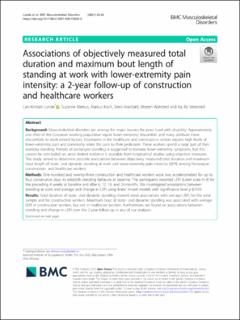| dc.description.abstract | Background Musculoskeletal disorders are among the major reasons for years lived with disability. Approximately one third of the European working population report lower-extremity discomfort and many attribute these discomforts to work-related factors. Employees in the healthcare and construction sectors reports high levels of lower-extremity pain and commonly relate the pain to their profession. These workers spend a large part of their workday standing. Periods of prolonged standing is suggested to increase lower-extremity symptoms, but this cannot be concluded on, since limited evidence is available from longitudinal studies using objective measures. This study aimed to determine possible associations between objectively measured total duration and maximum bout length of static- and dynamic standing at work and lower-extremity pain intensity (LEPi) among Norwegian construction- and healthcare workers. Methods One-hundred and twenty-three construction and healthcare workers wore two accelerometers for up to four consecutive days, to establish standing behavior at baseline. The participants reported LEPi (Likert scale 0–9) for the preceding 4 weeks at baseline and after 6, 12, 18, and 24 months. We investigated associations between standing at work and average and change in LEPi using linear mixed models with significance level p ≤ 0.05. Results Total duration of static- and dynamic standing showed weak associations with average LEPi, for the total sample and for construction workers. Maximum bout of static- and dynamic standing was associated with average LEPi in construction workers, but not in healthcare workers. Furthermore, we found no associations between standing and change in LEPi over the 2-year follow-up in any of our analyses. Conclusions This study indicate that objectively measured standing is associated with average LEPi over 2-years follow-up in construction workers, and that maximal bout of standing have a stronger association to LEPi than total duration. For every 10 min added to the maximal length of continuous standing during an average workday, we found approximately one unit increase in pain on a 0–9 scale. The lack of significant findings in analyses on healthcare workers suggest that the association between standing and LEPi depend on work-tasks, gender and/or other sector-specific factors. | |
